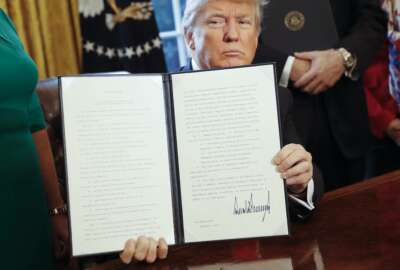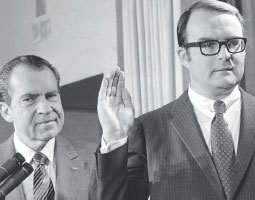

President Donald Trump signed an executive order calling on agencies to create regulatory reform task forces. The task forces will investigate how to "eliminate red...
Vowing that unnecessary and duplicative rules cannot “be an obstacle to government opportunity,” President Donald Trump directed federal agencies to establish regulatory reform task forces to start cutting red tape.
Trump signed the executive order which includes the task force directive, surrounded by business leaders in the Oval Office on Friday.
The directive aims to ensure “that every agency has a real team of dedicated people to research all regulations that are unnecessary, burdensome and harmful to the economy,” Trump said. “Each task force will make recommendations to repeal, or simplify existing regulations.”
Under the executive order, agencies have 60 days to designate a regulatory reform officer (RRO), who will “oversee the implementation of regulatory reform initiatives and policies to ensure that agencies effectively carry out regulatory reforms.”
Along with an RRO, agency task forces will evaluate existing regulations and “identify candidates for repeal or modification,” according to information provided by the White House.
The task force will include the RRO, a regulatory policy officer, someone from the agency’s central policy office or an equivalent office, and for large agencies the force must also include three senior officials.
“Each regulatory reform task force shall evaluate existing regulations and make recommendations to the agency head regarding their repeal, replacement, or modification, consistent with applicable law,” the EO said.
These regulations include ones that eliminate jobs, are “outdated or ineffective,” and those that “create a serious inconsistency or otherwise interfere with regulatory reform initiatives and policies.”
The task force should seek input from state and local governments, along with private sector stakeholders and businesses, the EO stated.
Within three months the task force needs to provide a progress report to the agency head, while the Office of Management and Budget Director Mick Mulvaney has two months to issue guidance on agency accountability.
The administration at the beginning of February issued guidance instructing agencies to revoke two rules for every one they introduce the rest of this fiscal year. During the Feb. 24 signing, Trump said that effort is “going to be tremendous.”
“What we’re doing [today] is much more than even that,” Trump said. “Every regulation should have to pass a simple test: Does it make life better, or safer for American workers or consumers? If the answer’s no, we will be getting rid of it and getting rid of it quickly.”
The regulatory reform is part of an overarching effort by the Trump administration to strengthen the economy and deliver on campaign promises to bring back American jobs.
“We cannot allow government to be an obstacle to government opportunity,” Trump said. “We are going to bring back jobs and create more opportunities to prosper, maybe more than ever before in our country.”
Sen. James Lankford (R-Okla.) said the order added “teeth” to retrospective review, by holding agencies accountable for regulatory reform.
“As the chairman of the Senate Subcommittee that deals with regulatory matters, we quickly found out that under the previous administration, agencies didn’t take retrospective review seriously,” Lankford said in a statement. “In addition, the time is now for regulatory improvements legislation so we can improve how regulations are created in the first place.”
Not everyone applauded the order.
In a statement from Robert Verchick, president of the Center for Progressive reform, Verchick said the EO is not about codifying the “one-in, two-out” order, but is “clearly aimed at embedding his overtly political, anti-protections agenda at federal agencies that are supposed to be using science and expertise to safeguard us all.”
“Agencies are once again being asked to waste scarce resources to target policies industry doesn’t like instead of protecting the American people and responding to new and emerging health, safety, and environmental hazards,” Verchick said. “This is not a good use of staff time at our federal agencies.”
Regulatory review doesn’t have to be a waste of time, according to some public policy experts, nor is it unusual for a president to ask agencies or OMB to do some spring cleaning on regulations.
“Things can get cumbersome, they can be out of touch with what’s happening on the ground,” said David Lewis, a political science professor and chairman of the Department of Political Science at Vanderbilt University. “Some kind of review or look back is a helpful step.”
Donald Kettl, a professor of public policy at the University of Maryland, said in an email to Federal News Radio that there are a large number of regulations “that have outlived their usefulness, that impose unnecessary burdens — both for government officials and for citizens, and that trip over themselves. It’s always useful to take a fresh look at the body of rules by which the government lives.”
But what’s different in this case, is how “aggressively” agencies are being asked to produce a task force to comb through existing regulations, Lewis said.
“The way that agencies implement legislation is through the rule-making process, and some of these things are relatively non-controversial and in fact are required by law through the Administrative Procedure Act,” Lewis said. “So you can’t just eliminate all regulations without basically telling Congress that they can’t pass laws.”
Rules can’t just be created or wiped out by a stroke of a pen, Kettl echoed.
“Because regulations — and de-regulations — are embedded in law and the APA, all regulations (and de-regulations) are subject to litigation by anyone who disagrees with what’s happening. That means the president’s executive order could produce fertile ground for legislation,” Kettl said. “That said, task forces could prove an excellent way to review the body of rules a department has created and is responsible for. Once created, many rules last forever. Circumstances often change and new rules can get in the way of old ones (and vice versa). A fresh look is a good idea.”
But both academics had their doubts on how much progress the EO will actually make in reducing redundant and burdensome regulations.
“It’s curious that the EO licenses department-based task forces but doesn’t contain any central oversight or data collection,” Kettl said. “OMB will issue guidance but not oversee implementation. Even more curious, there doesn’t seem to be any role for the Office of Information and Regulatory Affairs, OMB’s muscle on regulatory policy. So the administration is creating activity without overseeing it or measuring its results. How will we know what happens, other than anecdotes and self-reports by the departments?”
Lewis said one of the main frustrations businesses have with regulations is not that one specific agency has too many regulations, it’s that “multiple agencies are regulating at the same time,” he said. “This doesn’t solve that problem. Asking each agency to produce a regulatory task force … asks agencies within their own rule making to figure out what they can do.”
Copyright © 2025 Federal News Network. All rights reserved. This website is not intended for users located within the European Economic Area.


